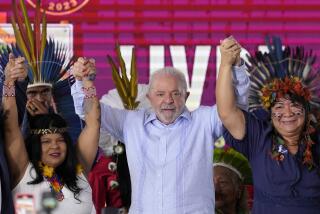Sending Message to Soviets Calls for Contras and More
- Share via
The sad and enduring lesson of the Bay of Pigs fiasco of 1961 is that this country must not begin any major foreign-policy military operation unless it has the will and the determination to complete it successfully. The failure of the United States to act decisively in Cuba led to the consolidation of the Castro regime and to the 1962 missile crisis, which brought the world to the brink of nuclear war. The United States’ lack of will to overthrow the Castro regime was the single most important element encouraging and accelerating Soviet involvement in Cuba and eventually transforming Cuba into a highly militarized and militant ally of the Soviets.
Another Bay of Pigs in Nicaragua and the consolidation of another Cuba would have an even more devastating effect. The inability of the United States to prevent the establishment of a Soviet military presence in Central America would alter the U.S.-Soviet strategic balance and diminish the United States’ global prestige and power image, thereby influencing Moscow’s policies and calculations of risk in other areas of the world.
What gives political change in Latin America special significance for U.S. interests is that it necessarily takes place in the context of East-West competition. When “adverse” changes occur in a region where the United States has had a long-term predominant influence, they cast doubt on U.S. ability to maintain its position in its own “backyard.” Such doubts will cause some states to reexamine their relationship with the United States or encourage others to challenge U.S. policies.
Political changes in Latin American countries, confronted with major economic and social problems, also generate opportunities for Soviet penetration. The Soviets have demonstrated a growing capability and willingness to take advantage of such opportunities, especially in regions of major U.S. interest.
Nicaragua offers the Soviets a golden opportunity. Since 1979 the Sandinistas have consolidated power and organized a Leninist dictatorship increasingly tied to Cuba and the Soviet Bloc. This profoundly anti-American group has established an internationalist militarized state not unlike Cuba, guided by Marxist-Leninist dogma. As Defense Minister Humberto Ortega likes to emphasize, “Marxism-Leninism is the scientific doctrine that guides our revolution.”
The Soviets see strategic as well as political advantages in Nicaragua. The possible use of Nicaragua’s Pacific ports for the Soviet navy, especially nuclear submarines; of the country’s recently refurbished airfields for the deployment of Soviet advanced aircraft, and of Nicaragua as a base for subversion--all would pose significant long-term problems for the United States and could lead to a Soviet-American crisis.
It would be a serious error for U.S. security interests to view Nicaragua in isolation from the rest of the world. The decline of the United States’ power and influence in its “strategic rear” and its failure to dislodge the Sandinistas from power are perceived by Moscow as particularly strong evidence that the correlation of world forces is shifting in its favor. As Karen Brutents, deputy director of the International Department of the Soviet Communist Party Central Committee, gloated, “The fact that U.S. imperialism did not dare drown the Nicaraguan revolution in blood proves that the world situation has changed and that the socialist countries’ solidarity with the liberation movement is of paramount importance.”
U.S. policy in Nicaragua, therefore, should aim toward preventing a Soviet military presence, ousting the Sandinista leadership and establishing a pro-Western democratic government. U.S. economic sanctions will not oust the Sandinistas or bring them to their knees. The limited aid being provided to the freedom fighters probably will not do the job, either. Increased military aid, support for the anti-Sandinista groups fighting in the south and the development of an urban underground movement--all lacking at present--should be part of our overall strategy. Yet even these actions may not be sufficient.
The contras are no match for the powerful Sandinista army equipped and supported by Cuba and the Soviet Union. While disillusionment with the revolution has increased significantly, this malaise is not likely to develop into massive uprisings against the regime. On the contrary, fleeing Nicaragua seems to be the most popular response to disillusionment and Sandinista terror. The possibility of leaving provides an escape valve for discontent and prevents an increase of internal tensions. Segments of the freedom fighters also seem to lack the determination and risk-taking courage of guerrillas in other countries. There seems to be a willingness to wait it out in the hope of a collapse of the regime, which is not likely to occur, or of a U.S. intervention.
The options for the United States are narrowing. Either we negotiate a truce with the Sandinistas, which would allow the further consolidation of a Leninist system and the eventual growth of Soviet military power in Central America, or we make a concerted effort to remove them--an effort that might require a U.S. military intervention.
While the latter option has risks and implications, it seems the only plausible one at this juncture. Another Bay of Pigs is unacceptable. U.S. intervention in Nicaragua would eliminate a Soviet client state from Central America, weaken the guerrillas in El Salvador, deny Cuba an important ally and, more significantly, send out a message about our determination and will to resist Soviet-Cuban advances.
More to Read
Sign up for Essential California
The most important California stories and recommendations in your inbox every morning.
You may occasionally receive promotional content from the Los Angeles Times.










